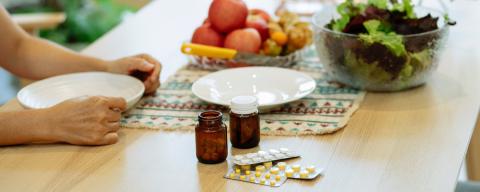Common Interactions Between Food and Drugs
Some foods can interact with your medications, making the risk of harmful side effects higher by changing how the medicine is absorbed, or how it works inside the body.1 These interactions with food might make your medicine less effective, or they might cause overdose effects.1 It is therefore important to find out which foods will interact with the medicines you use.
Statins are medicines that are used by many people to lower their cholesterol level. If you use statins, you should be aware of several possible interactions with food. Grapefruit juice has been shown to increase the effects of statins.2 In fact, grapefruit can have an effect on more than 85 different medicines!2 Also, statins can be affected by overall food intake. Some statins, like lovastatin (Mevacor), are better absorbed by the body when taken with a meal.3 Other statins, such as rosuvastatin (Crestor), are better absorbed by the body when taken on an empty stomach.3 Many others, including simvastatin (Zocor) and pravastatin (Pravalchol), are absorbed just as well with food or on an empty stomach.3 However, taking statins with large amounts of soluble fibers like pectin or oat bran might lower absorption.3
High blood pressure is another health concern for many people, and several medicines used to lower blood pressure can be affected by the foods you eat. Taking an ACE inhibitor, such as lisinopril, on an empty stomach increases the body’s absorption of those medicines.4 Licorice extract can raise blood pressure by making the body less sensitive to ACE inhibitors.5 Orange juice can decrease the body’s absorption of celiprolol, which is a blood pressure medicine called a beta-blocker.6 Grapefruit juice can increase the amount of Felodipine in the body, which is a calcium channel blocker used to treat high blood pressure, possibly to toxic levels.7 MAOI medicines are used to treat depression, and can interact with foods such as aged cheese, yogurt, salami, and other foods which contain tyramine.8 The interaction between foods that contain tyramine and MAOI medicines can cause blood pressure to become very high.8
Warfarin (Coumadin) is another medicine that is used by many people to prevent blood clots and can be impacted by food. Eating a low-carbohydrate, high-protein diet has been shown to make warfarin work less well.9 Vitamin K, which is found in kale, spinach, broccoli, and other vegetables, also interacts with warfarin.10 Vitamin K is very important, and the vegetables that it is found in are very good for you, so do not avoid vitamin K foods, even if you use warfarin. Instead, you should try to consume the same of vitamin K every day, because it is the sudden changes in vitamin K that can decrease the effectiveness of warfarin.
Even antibiotic medicines might not work as well due to the foods you might eat.11 Dairy foods like milk, yogurt, and cheese contain minerals such as calcium and magnesium. These might decrease or prevent absorption of some antibiotics, so it is best to eat dairy foods at other times of day when you are not taking an antibiotic.12
As you can see, there are many interactions between common foods and widely used medicines. It is impossible to present a complete list in a short article, and it is hard for people – even experts – to know all the risky combinations of food and medicine. It is important to look into your own medicines to see if there are any interactions with food that might affect you. Your doctor or your pharmacist can answer questions about your medicines, and a registered dietitian can help you learn about how the foods you eat might affect your current medicines. With just a little bit of research, you can make sure that the food you eat and the medicines you use will work to keep you in the best possible health!
References
- Genser D. Food and drug interaction: consequences for the nutrition/health status. Ann Nutr Metab. 2008;52 Suppl 1:29-32. doi:10.1159/000115345
- Lee JW, Morris JK, Wald NJ. Grapefruit Juice and Statins. Am J Med. 2016;129(1):26-29. doi:10.1016/j.amjmed.2015.07.036
- Vaquero MP, Sánchez Muniz FJ, Jiménez Redondo S, Prats Oliván P, Higueras FJ, Bastida S. Major diet-drug interactions affecting the kinetic characteristics and hypolipidaemic properties of statins. Nutr Hosp. 2010;25(2):193-206
- Yaheya, Mohammad & Lecturer, In. Drug-food interactions and role of pharmacist. Asian Journal of Pharmaceutical and Clinical Research. 2009;2(4):1-10
- Størmer FC, Reistad R, Alexander J. Glycyrrhizic acid in liquorice--evaluation of health hazard. Food Chem Toxicol. 1993;31(4):303-312. doi:10.1016/0278-6915(93)90080-i
- Uesawa Y, Mohri K. Hesperidin in orange juice reduces the absorption of celiprolol in rats. Biopharm Drug Dispos. 2008;29(3):185-188. doi:10.1002/bdd.603
- de Castro WV, Mertens-Talcott S, Derendorf H, Butterweck V. Grapefruit juice-drug interactions: Grapefruit juice and its components inhibit P-glycoprotein (ABCB1) mediated transport of talinolol in Caco-2 cells. J Pharm Sci. 2007;96(10):2808-2817. doi:10.1002/jps.20975
- Volz HP, Gleiter CH. Monoamine oxidase inhibitors. A perspective on their use in the elderly. Drugs Aging. 1998;13(5):341-355. doi:10.2165/00002512-199813050-00002
- Hornsby LB, Hester EK, Donaldson AR. Potential interaction between warfarin and high dietary protein intake. Pharmacotherapy. 2008;28(4):536-539. doi:10.1592/phco.28.4.536
- Karlson B, Leijd B, Hellström K. On the influence of vitamin K-rich vegetables and wine on the effectiveness of warfarin treatment. Acta Med Scand. 1986;220(4):347-350. doi:10.1111/j.0954-6820.1986.tb02776
- Hodel M, Genné D. Antibiothérapie: interactions médicamenteuses et alimentaires [Antibiotics: drug and food interactions]. Rev Med Suisse. 2009;5(220):1979-1984.
Füredi P, Pápai K, Budai M, Ludányi K, Antal I, Klebovich I. Fluorokinolonok in vivo étel-interakciós vizsgálatai [In vivo effect of food on absorption of fluoroquinolones]. Acta Pharm Hung. 2009;79(2):81-87
Check Out Our New Health & Well-Being Page
Our specialists help create healthy people and healthy places in New Hampshire.
Featured LINK
Mental Health Resources for New Hampshire - a printable county-specific guide to help New Hampshire residents find local, state, and national mental health resources.

